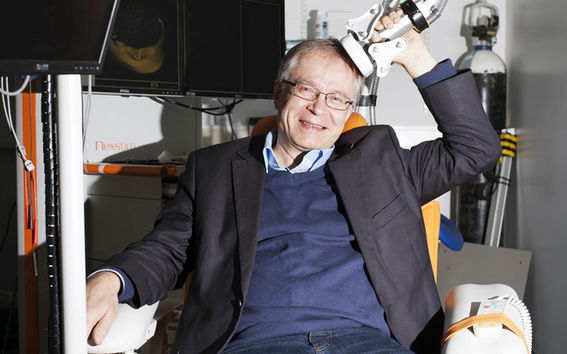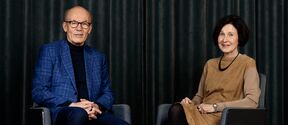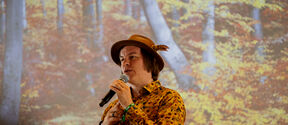Neurotechnology can benefit millions

Surgery for brain tumours and epilepsy involves millimetre precision – a misplaced cut could result in loss of mobility or speech.
In the past, neurosurgeons had to penetrate the skull before they could locate the cortical centres that control key functions and to plan the operation in a way that would not damage them. With the aid of the navigated brain stimulation (NBS) technique, surgeons can now perform this charting noninvasively from outside the skull using magnetic pulses.
“Competing devices that utilise magnetic stimulation emit pulses either with no navigation or they do it less accurately. Our equipment makes it possible to focus the stimulation very precisely using three-dimensional structural images while an EEG cap provides data on changes to the brain's electrical activity and the other sensors on speech ability or muscle movements,” Academy Professor Risto Ilmoniemi, one of the original developers of NBS, explains.
Small steps, major achievements
The roots of NBS and the brain research being conducted at Aalto University extend to the early 1980s, when Helsinki University of Technology (HUT) Professor Olli V. Lounasmaa started to explore the secrets of the human mind alongside his work on low-temperature quantum physics. Part of his research group started to develop multichannel MEG devices for measuring brain activity.
“It was difficult in the beginning, and it took years before we started to realise that this would actually be useful,” recalls Ilmoniemi, who joined the group in 1978 while still an undergraduate.
“Individual steps forward can often feel very minor to researchers, but may very well build up to major achievements over the years.”
The O.V. Lounasmaa Laboratory's expertise in MEG gradually made it world-famous and physicians and psychologists like Riitta Hari and Risto Näätänen with their students began to use the equipment and develop applications. Ilmoniemi thinks that one of the strengths of Aalto's and its predecessor HUT's brain research is the close relationship maintained with medical science experts. An example of this cooperation is the BioMag Laboratory which is a joint venture between Aalto, the University of Helsinki and the Hospital District of Helsinki and Uusimaa. Numerous other hospitals in Finland and abroad are also engaged. One of the key persons developing the collaboration with the hospital and establishing the BioMag Laboratory was professor Toivo Katila, the founder of the Laboratory of Biomedical Engineering of HUT. After moving to the BioMag Laboratory and supported by Katila, Ilmoniemi started to develop technology for NBS and the combination of NBS and EEG.
“Finnish universities cannot compete with, say, their US counterparts when it comes to buying the most expensive items of equipment. Nevertheless, we've had access to the world's best devices before anyone else because we build them ourselves,” Ilmoniemi sums up.
Aiming for a wonder cap
This hardware expertise has also generated growing and international business activities. One successful venture is Nexstim Plc, which Ilmoniemi established together with Pekka Puolakka and Markku Lahdenpää, in 2000 to commercialise NBS. Its devices are now used by all of Finland's university hospitals as well as in some twenty countries ranging from Russia to Canada and Japan.
Nexstim was listed on the stock exchange last year to attract capital for commercialising a stroke therapy it has developed on the basis of NBS. The NBS method itself has already received approval from the US Food and Drug Administration, the world's most significant oversight authority for medical use and sales permits. Therapy use would multiply the company’s growth potential: each year, about 800,000 people suffer a stroke in the USA alone – and about a third of them could benefit from Nexstim's therapy.
Ilmoniemi notes that there have been promising trials of using magnetic stimulation to treat depression, chronic pain, various addictions and tinnitus in Finland. The number of people who might benefit from this is enormous: serious depression afflicts 150 million people around the world, while 40 million suffer from epilepsy and 25 million from schizophrenia. Presently, there are plans for a major European research project that would further enhance the functionality of magnetic stimulation by substituting human control with a computer algorithm.
“This will enable us to stimulate simultaneously several locations, thus providing effective access to neuronal networks, which connect to different parts of the brain. The device will also measure brain’s reactions and the program will adjust the stimulation accordingly. The aim is to develop self-guiding diagnostic and therapeutic procedures for our wonder cap that connects wirelessly to the brain,” Ilmoniemi says with a smile.
Many top research groups, hospitals and businesses from around Europe are participating in the Aalto-coordinated venture to develop the next-generation, feedback-controlled TMS. Ilmoniemi says that a simple test device may be finished within the year, but hospitals will have to wait longer for their wonder caps.
“Ten years is a realistic schedule for a clinical breakthrough,” he concedes.
“Results don't come about instantly in this line of work, but they can have absolutely enormous significance.”
Text: Minna Hölttä
Photos: Terhi Korhonen
The original article has been publishes in the Aalto University Magazine issue 13. (issuu.com)
Read more news
Apply to be a guest professor or visiting researcher at the Université Grenoble Alpes
Unite! partner, Université Grenoble Alpes (UGA) has opened a call to host international professors and researchers for short stays.
Postdoctoral researcher Eloi Moliner makes history as a 5-time award winner
Eloi Moliner is one of the most decorated doctoral researchers in Aalto University's history – we would like to highlight his success and contributions to the field of audio signal processing
2 million euro donation to Aalto University's new multidisciplinary Bachelor’s programme – Donors: Matti Alahuhta, Sari Baldauf, Antti Herlin, and Jorma Ollila
Set to launch in autumn 2027, the multidisciplinary Bachelor's programme combines technology, business, arts, and design






